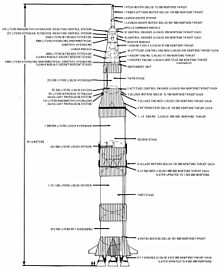Ullage
Ullage or headspace is the unfilled space in a container, particularly with a liquid.[1]
Etymology
The word comes ultimately from the Latin oculus, “eye”, which was used in a figurative sense by the Romans for the bung hole of a barrel. This was taken into French in the medieval period as oeil, from which a verb ouiller was created, to fill a barrel up to the bung hole. In turn, a noun ouillage was created, which was the immediate source of the word's modern form, first recorded in Norman English about 1300, at first in the sense of the amount of liquid needed to fill a barrel up to the bung hole.
Wine and spirits
By an obvious extension, ullage came to refer to any amount by which a barrel is unfilled, perhaps because some of the contents have been used. It is also applied to the unfilled air space at the top of a bottle of wine, which in this case is essential to allow for expansion of the contents as the temperature changes.
Beer
By further extension, in brewing and beer retail, ullage is the residue of beer left in a barrel that has been emptied. When calculating tax returns and the like, licensed premises owners, landlords or managers can factor in the duty on ullage, or unavoidable barrel wastage.[2] Ullage therefore has come to be used as a general term, in the licensed trade, for waste beer whether at the barrel or at the bar tap or pump. However, what customers leave in their glasses does not count as ullage, because it has been sold.
Rocketry

Liquid propellant rockets store their propellants in tanks. Cryogenic tanks are never completely filled, in order to allow for the expansion of the cold liquid propellant. On the ground, the space between the top of the propellant load and the top of the tank is known as "ullage space". Although this does not happen in the weightless condition in space without engine thrust, empty space still occurs in partially filled tanks, and the liquid floats away from the engine intake, which is undesirable for stable engine operation. Small rocket engines are sometimes used to provide enough acceleration to settle the propellant to the bottom of the tanks prior to ignition of the main engine(s). Engines devoted to this purpose are called ullage motors; sometimes reaction control system thrusters are used.
Industrial use
Ullage is also widely used in industrial or marine settings to describe the empty space in large tanks or holds used to store or carry liquids or bulk solids such as grain.[3] In accordance with IMO regulations, the Code of Federal Regulations, and the ABS Rules for Steel Vessels, certain pressurized tanks on steel ships may not be filled greater than 98% full, although there are exceptions. This is so that the pressure relief valve is always in contact with a gas or vapor. Certain pressure relief valves for chemical use are not designed to relieve the pressure when in contact with liquids.
In some cases, the ullage in a ship's hold can be relevant to stability; liquid or dry bulk cargo in a part-filled hold can shift asymmetrically towards one side as the ship heels to one side and the other, reducing the margin of stability when compared with a full hold. Excessive ullage in a tank may contribute to the free surface effect. When referring to the free surface effect, the condition of a tank that is not full is described as a "slack tank", while a full tank is "pressed up".[4]
References
- ABS Rules for Steel Vessels 2007, Part 5C
- ^ Soroka, W. Illustrated Glossary of Packaging Terminology (Second ed.). Institute of Packaging Professionals.
- ^ http://www.hmrc.gov.uk/manuals/beermanual/beer3880.htm
- ^ COAST GUARD BALTIMORE MD FIELD TESTING AND DEVELOPMENT CENTER: Grain ullages
- ^ Ship inspection maritime guide.
